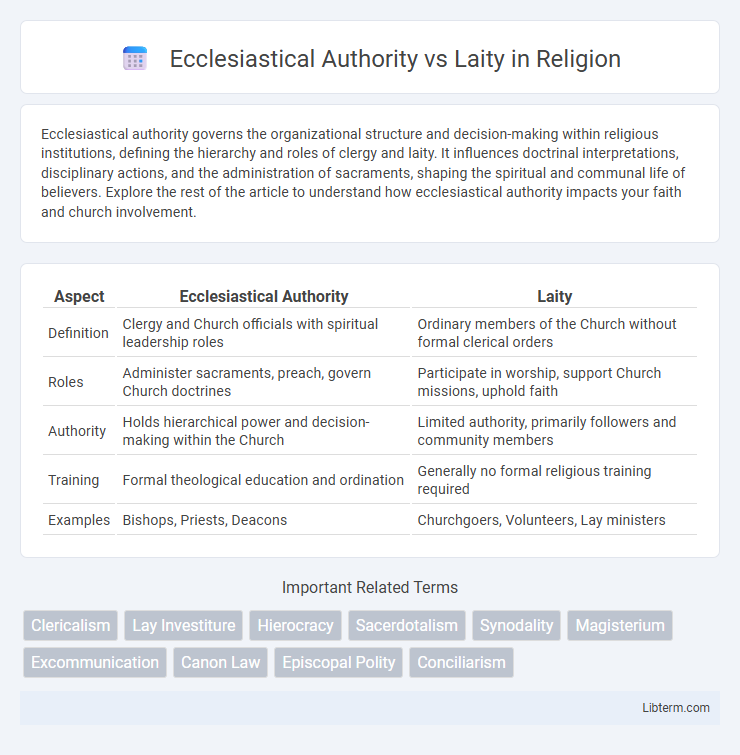Ecclesiastical authority governs the organizational structure and decision-making within religious institutions, defining the hierarchy and roles of clergy and laity. It influences doctrinal interpretations, disciplinary actions, and the administration of sacraments, shaping the spiritual and communal life of believers. Explore the rest of the article to understand how ecclesiastical authority impacts your faith and church involvement.
Table of Comparison
| Aspect | Ecclesiastical Authority | Laity |
|---|---|---|
| Definition | Clergy and Church officials with spiritual leadership roles | Ordinary members of the Church without formal clerical orders |
| Roles | Administer sacraments, preach, govern Church doctrines | Participate in worship, support Church missions, uphold faith |
| Authority | Holds hierarchical power and decision-making within the Church | Limited authority, primarily followers and community members |
| Training | Formal theological education and ordination | Generally no formal religious training required |
| Examples | Bishops, Priests, Deacons | Churchgoers, Volunteers, Lay ministers |
Defining Ecclesiastical Authority
Ecclesiastical authority refers to the established leadership structure within a religious organization, typically consisting of clergy who possess the power to govern, interpret doctrine, and administer sacraments. This authority is often vested in bishops, priests, or other ordained officials who maintain doctrinal purity and oversee the spiritual welfare of the congregation. In contrast, the laity comprises non-ordained members who participate in the faith community without holding formal governance roles.
Who Are the Laity?
The laity comprises non-ordained members of a religious community who participate in the faith outside of ecclesiastical authority. They play essential roles in worship, ministry, and church activities while lacking formal clerical powers such as sacramental administration or doctrinal governance. This distinction underscores the unique responsibilities and spiritual contributions between ordained clergy and laypersons within religious institutions.
Historical Evolution of Church Governance
The historical evolution of church governance reveals a dynamic tension between ecclesiastical authority and laity, marked by shifting power structures from early Christian communities to modern denominations. Initially, apostolic leadership centralized authority within bishops and clergy, formalized through councils such as Nicaea (325 AD), which codified hierarchical roles and doctrines. The Protestant Reformation fundamentally challenged this clerical dominance by advocating for greater lay participation, leading to diverse ecclesiastical models emphasizing either episcopal, presbyterian, or congregational authority frameworks.
Scriptural Foundations for Authority and Participation
Ecclesiastical authority finds its scriptural foundation primarily in passages such as Matthew 16:18-19, where Christ grants Peter the keys of the kingdom, signifying a divinely instituted leadership, and in 1 Timothy 3:1-13, outlining qualifications for church leaders. The laity's participation is grounded in 1 Peter 2:9, which describes believers as a "royal priesthood," emphasizing active spiritual involvement and communal responsibility. This balance between hierarchical authority and lay participation stems from the New Testament's vision of a unified, yet ordered, body of Christ.
Roles and Responsibilities: Clergy vs. Laity
Ecclesiastical authority primarily resides within the clergy, who are responsible for administering sacraments, interpreting doctrine, and providing spiritual guidance to the congregation. The laity, comprising non-ordained church members, engage in supporting roles such as participating in worship, community outreach, and upholding church teachings in daily life. Clergy possess formal responsibilities tied to church governance and liturgical functions, whereas laity focus on active involvement and service within the ecclesial community.
Tensions and Conflicts: Case Studies
Tensions between Ecclesiastical Authority and Laity often arise due to differing interpretations of doctrine and church governance, as demonstrated in the Investiture Controversy of the 11th century where secular rulers challenged papal authority over bishop appointments. The Protestant Reformation, led by figures like Martin Luther, highlighted conflicts over lay access to scripture and clerical abuses, ultimately reshaping church-state relations and empowering the laity. Contemporary case studies, such as debates over LGBTQ+ inclusion in various denominations, continue to reveal deep-seated conflicts between hierarchical decisions and grassroots laity demands.
The Impact of Authority on Church Decision-Making
Ecclesiastical authority significantly influences church decision-making by centralizing power in ordained leaders, shaping doctrinal interpretations, and guiding community practices. The laity's role often varies, with involvement in decision-making processes contingent on denominational structures and levels of congregational participation. The dynamic between hierarchical control and lay input directly impacts the governance, accountability, and responsiveness of church institutions.
Lay Movements and Calls for Reform
Lay movements such as the Catholic Charismatic Renewal and Opus Dei have significantly influenced ecclesiastical authority by advocating for greater lay participation in church decisions, challenging traditional clerical hierarchies. Calls for reform persistently emphasize transparency, accountability, and inclusivity within the Church's governance, pushing for a balance where the laity's voice is acknowledged alongside the clergy's. This dynamic tensions ecclesiastical authority by reshaping power structures and encouraging collaborative pastoral leadership.
Modern Trends in Power Sharing
Modern trends in power sharing between ecclesiastical authority and the laity emphasize increased lay participation in decision-making bodies, reflecting a shift toward democratization within religious institutions. Many denominations have implemented synodal structures and councils where lay members hold voting rights alongside clergy, promoting transparency and accountability. This evolving balance fosters collaborative leadership models that integrate pastoral guidance with the diverse perspectives of the faithful.
Shaping the Future: Collaboration or Division?
Ecclesiastical authority and the laity play pivotal roles in shaping the Church's future, with their interaction determining either collaboration or division. The balance of power, mutual respect, and shared vision influences the effectiveness of decision-making processes and the Church's ability to address contemporary challenges. Emphasizing inclusive dialogue and joint responsibility fosters unity and strengthens the Church's mission in a rapidly evolving religious landscape.
Ecclesiastical Authority Infographic

 libterm.com
libterm.com